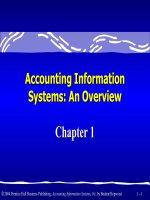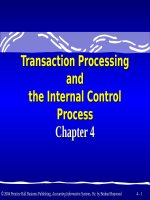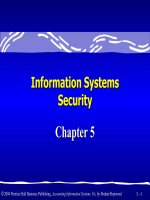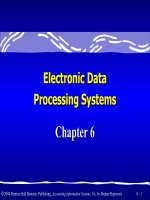Accounting information system an overview 9e bodnar hopwood chapter 06
Bạn đang xem bản rút gọn của tài liệu. Xem và tải ngay bản đầy đủ của tài liệu tại đây (3.71 MB, 52 trang )
Electronic Data
Processing Systems
Chapter 6
2004 Prentice Hall Business Publishing, Accounting Information Systems, 9/e, by Bodnar/Hopwood
6–1
Learning Objective 1
Describe how application
controls are used in data
processing systems to
ensure accuracy
and integrity.
2004 Prentice Hall Business Publishing, Accounting Information Systems, 9/e, by Bodnar/Hopwood
6–2
Paper-Based Input System
In some computerized accounting systems,
inputs to the system are based on
handwritten or typed source documents.
These documents are then collected and
forwarded to computer operations for
error checking and processing.
2004 Prentice Hall Business Publishing, Accounting Information Systems, 9/e, by Bodnar/Hopwood
6–3
Preparation and Completion
of the Source Document
The source document, such as sales
orders, are prepared manually.
Errors can be minimized if the
source document is well designed
and easy to understand.
2004 Prentice Hall Business Publishing, Accounting Information Systems, 9/e, by Bodnar/Hopwood
6–4
Transfer of Source Documents
to Data Processing
Batch control totals and data transfer
registers controls data transfers.
User’s departments
Data processing
2004 Prentice Hall Business Publishing, Accounting Information Systems, 9/e, by Bodnar/Hopwood
6–5
Transfer of Source Documents
to Data Processing
Document counts are a simple
form of batch control.
Batch totals may be taken for all or several
numeric fields in the original data file.
2004 Prentice Hall Business Publishing, Accounting Information Systems, 9/e, by Bodnar/Hopwood
6–6
Transfer of Source Documents
to Data Processing
Data entry
Key verification
Visual verification
Program data editing
2004 Prentice Hall Business Publishing, Accounting Information Systems, 9/e, by Bodnar/Hopwood
6–7
Program Data Editing Techniques
Data editing routines may be applied
to each of the basic data structures.
Character
Fields
Records
Files
2004 Prentice Hall Business Publishing, Accounting Information Systems, 9/e, by Bodnar/Hopwood
6–8
Program Data Editing Techniques
What is a table lookup?
It is an editing program that compares
the value of a field to the acceptable
values contained in a table file.
2004 Prentice Hall Business Publishing, Accounting Information Systems, 9/e, by Bodnar/Hopwood
6–9
Program Data Editing Techniques
Limit test
Continuous operations auditing
Check digit
Valid code check
2004 Prentice Hall Business Publishing, Accounting Information Systems, 9/e, by Bodnar/Hopwood
6–
Paperless Input Systems
In paperless input systems, sometimes called
online input systems, transactions are input
directly into the computer network.
Possible loss of segregation
of duties and audit trail.
2004 Prentice Hall Business Publishing, Accounting Information Systems, 9/e, by Bodnar/Hopwood
6–
Paperless Input Systems
Source
document
Preparation
Data entry
Performed by the same person
2004 Prentice Hall Business Publishing, Accounting Information Systems, 9/e, by Bodnar/Hopwood
6–
Paperless Input Systems
Transaction logs or transaction registers
are created by logging all inputs to a
special file that automatically contains
tags to identify transactions.
2004 Prentice Hall Business Publishing, Accounting Information Systems, 9/e, by Bodnar/Hopwood
6–
Paperless Input Systems
What is tagging?
It means that additional, audit-oriented
information is included with
original transaction data.
2004 Prentice Hall Business Publishing, Accounting Information Systems, 9/e, by Bodnar/Hopwood
6–
Paperless Input Systems
Online manual data entry systems
Automatic identification systems
2004 Prentice Hall Business Publishing, Accounting Information Systems, 9/e, by Bodnar/Hopwood
6–
Paperless Input Systems
Transactions in paperless input systems
involving human intervention typically
proceed through two phases.
1. Data entry and data editing
2. Transfer to the host application system
2004 Prentice Hall Business Publishing, Accounting Information Systems, 9/e, by Bodnar/Hopwood
6–
Paperless Input Systems
Networked vending machine (NVM)
Electronic data interchange (EDI)
2004 Prentice Hall Business Publishing, Accounting Information Systems, 9/e, by Bodnar/Hopwood
6–
Learning Objectives 2 and 3
Characterize the various
types of electronic systems
used for processing.
Describe the basic functions
of a computerized
accounting application.
2004 Prentice Hall Business Publishing, Accounting Information Systems, 9/e, by Bodnar/Hopwood
6–
Paper-Based Processing Systems
Weekly time reports to produce paychecks
Groups of checks to update
accounts payable master files
Processing invoices to update an
accounts receivable master file
2004 Prentice Hall Business Publishing, Accounting Information Systems, 9/e, by Bodnar/Hopwood
6–
Paper-Based Processing Systems
Sequential file updating
Random-access file updating
2004 Prentice Hall Business Publishing, Accounting Information Systems, 9/e, by Bodnar/Hopwood
6–
Batch Processing with
Sequential File Updating
Preparing the transaction file
Updating the master file
Updating the general ledger
Preparing general ledger reports
2004 Prentice Hall Business Publishing, Accounting Information Systems, 9/e, by Bodnar/Hopwood
6–
Sequential File Processing
Invoices
1
2
Data
terminal
Process
input
3
Transaction
file
Batch
balance
A
2004 Prentice Hall Business Publishing, Accounting Information Systems, 9/e, by Bodnar/Hopwood
6–
Sequential File Processing
A
4
5
Transaction
file
Edit
program
Control
report
14
6
7
Good data
file
Sort to
master file
sequence
Rejected
data
Control
report
13
Reconcile
Control
procedure
2004 Prentice Hall Business Publishing, Accounting Information Systems, 9/e, by Bodnar/Hopwood
6–
Sequential File Processing
8
Sorted
transaction
file
11
New
master
Control
data
10
Master file
update
12
Transaction
file
9
Old master
file
Old
master
Retain for
backup 15
2004 Prentice Hall Business Publishing, Accounting Information Systems, 9/e, by Bodnar/Hopwood
6–
Son–Father–Grandfather
Master Files
Old
Father master
file
File
update
Backup
Grandfather master
file
New
Son master
file
2004 Prentice Hall Business Publishing, Accounting Information Systems, 9/e, by Bodnar/Hopwood
Next
file
update
6–









